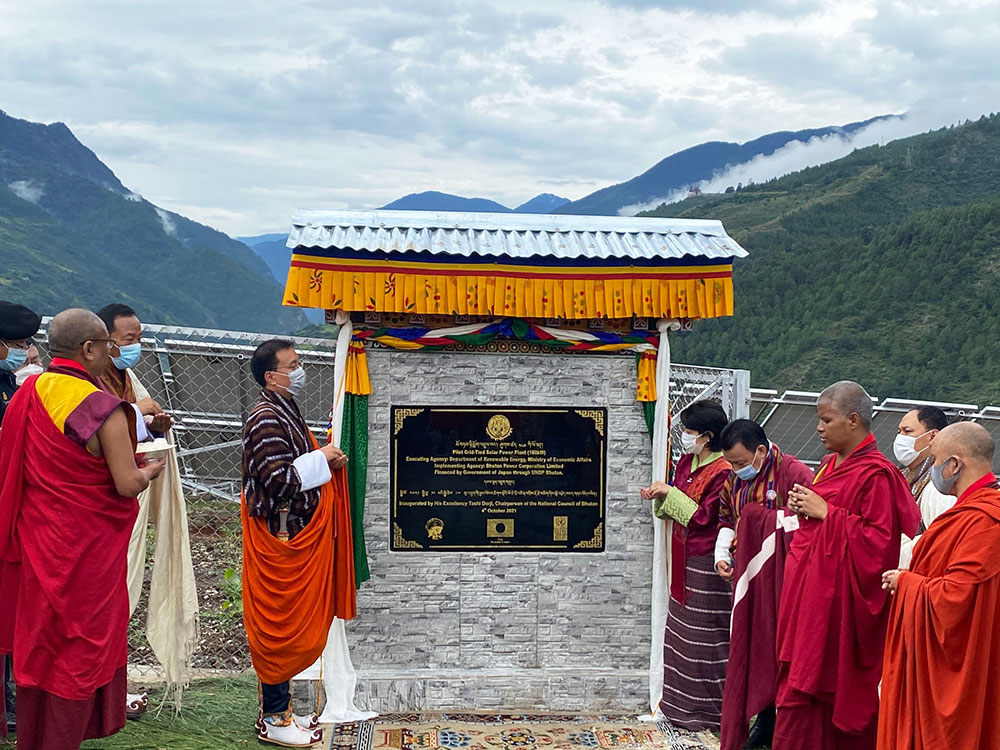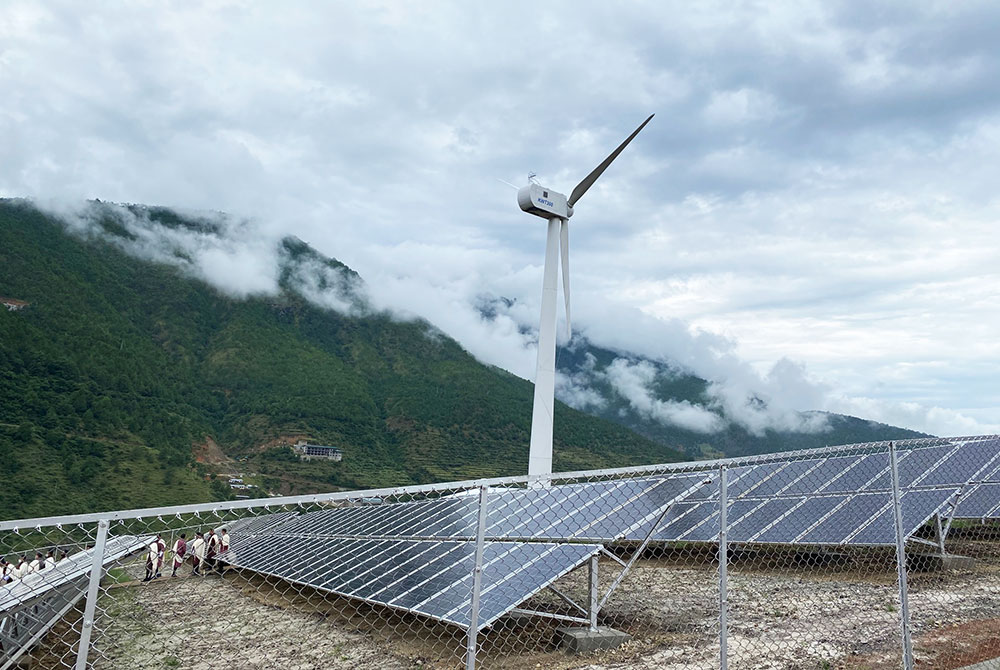Phurpa Lhamo | Wangdue
Inching a step closer to Bhutan’s aim of energy security through a diversified and sustainable energy supply mix, a 180-kilowatt (kW) grid-tied solar power plant project was inaugurated yesterday at Ruebisa, Wangdue.
The pilot project is the first of its kind in the country, and the energy generated from the project is feeding electricity into the national grid for distribution.
With 464 solar panels, the 180kW plant will produce 263,000 units of energy a year, which is adequate to meet the electricity supply demands for around 90 households.
Director of the Department of Renewable Energy (DRE), Phuntsho Namgyal, said that Bhutan was endowed with 12,000 megawatts (MW) of solar power potential.
He added that today, a negligible percentage (next to zero) of solar energy is tapped.

National Council Chairperson Tashi Dorji and UNDP Bhutan’s Resident Representative Azusa Kubota inaugurate the project
He said that the current pilot project of the 180kW solar plant brings Bhutan’s utility scale solar power generation dream closer.
The pilot project engaged around 10 engineers and technicians from the DRE and Bhutan Power Corporation (BPC), who carried out the design, construction, installation, and grid integration work. Further, locals were involved through local contractors to execute the work.
Phuntsho Namgyal said that while engineers and technicians had theoretical knowledge on solar plants, it was the first time that the staff had received hands-on experience at such a scale.
“When our engineers and technicians are trained, we can have better design, better technical coordination, better tendering specification formulations; it would be directly helpful in several areas.”
He added that those involved would greatly benefit and take part in Bhutan’s upcoming solar projects. One imminent project is the construction of Bhutan’s first mega solar power plant, a 17MW plant in Sephu, Wangdue.
Today, all of Bhutan’s electricity generation is from renewables such as hydropower, wind, and solar. However, 78 percent of the country’s energy consumption is supplied by fossil fuels, largely for transportation purposes.
Satoshi Suzuki, Ambassador of Japan to Bhutan, said that in Bhutan the energy mix consists primarily of hydroelectricity, owing to abundant fast-flowing rivers.
He added that in winter however, due to reduced flow of water into the rivers, there isn’t enough water available for power generation.
“I hope that this solar power system will help in improving Bhutan’s energy security, which is indispensable for the socioeconomic development of the country. I hope that these Solar Photovoltaic Facilities will be effectively used for many years to come.”
Further, the UNDP Resident Representative, Azusa Kubota, said that Bhutan was heavily dependent on hydropower as its energy source, an energy system that is vulnerable to glacial lake outburst floods (GLOFs), flash floods, and reduced flows in the river systems during winter months. “These are subject to the direct impact of climate change. Strengthening the reliability of the energy sector must be at the heart of Bhutan’s recovery efforts.”
She said: “This project is an example of both climate change adaptation and mitigation. By enhancing energy availability during the lean winter months when hydro generation decreases, the project is an adaptation response to climate change. And, by exporting surplus electricity to the Indian grid, it helps mitigate greenhouse gas (GHG) emissions in India, thus becoming a mitigation project.”
In addition to the 600kW wind turbines at Ruebisa, the 180kW solar plant will serve as learning material for students studying renewable energy.
Phuntsho Namgyal said that the pilot plant will not only demonstrate the viability of the solar power in Bhutan but also demystify several things. “For instance, solar power has always been equated to a subsistence-level substitute for kerosene lamps for home lighting in some far-off rural villages, which cannot power meaningful appliances like rice cookers, water boilers, TVs, etc.”
He added: “Solar power can not only power a full suite of household appliances, but also power powerful tools in households so that a carpenter, tailor, and a farmer can improve their productivity and get one’s business to work and make oneself part of the productive economy.”
The USD 210,000 project was executed by DRE in collaboration with BPC as the implementing agency. The project was funded by the government of Japan, supported by UNDP.
Edited by Jigme Wangchuk


